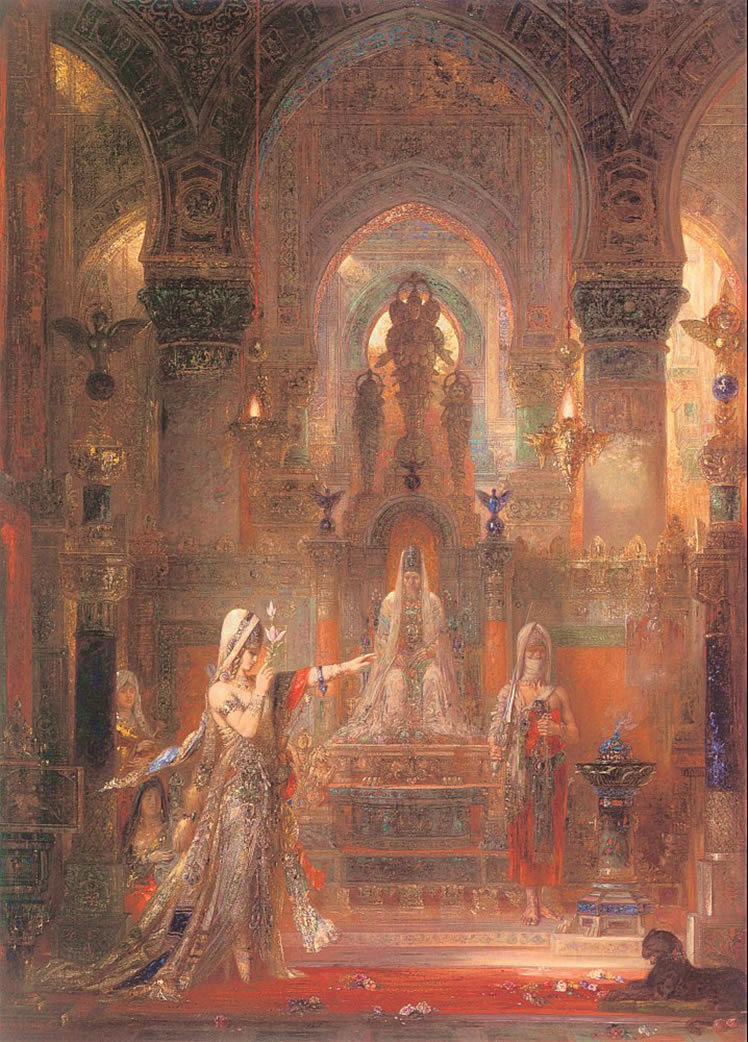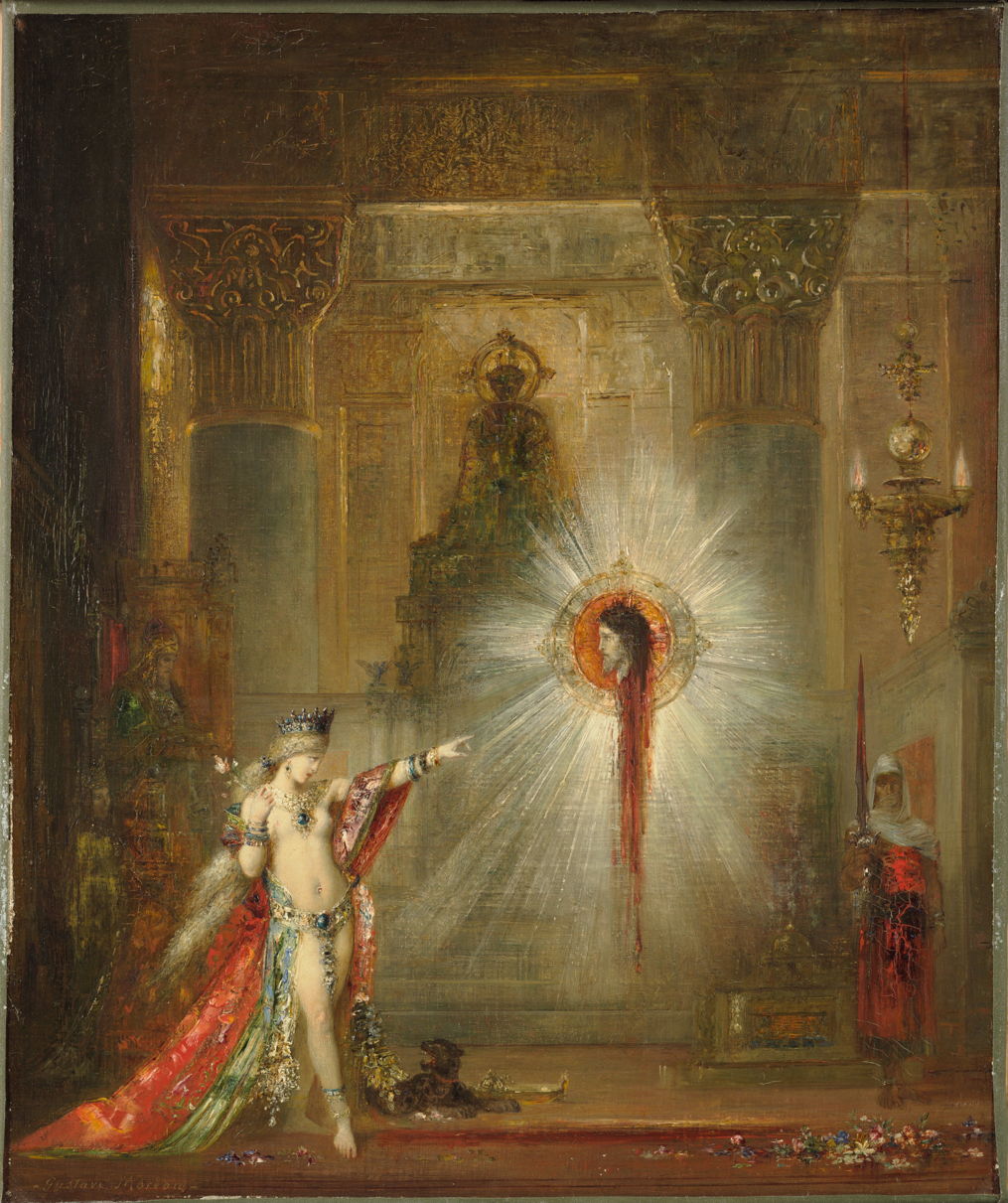For artists like Gustave Moreau who remained in Paris, the Franco-Prussian War and the violence, destruction and death of the Commune in its aftermath must have been terrifying. Yet it was also a period during which Moreau developed one of his most important and influential themes: Salome.
The original narrative is biblical, and straightforward. The unnamed daughter (subsequently identified as Salome) of Herodias performed a dance at a birthday feast thrown by King Herod. The dance so pleased Herod that he offered her anything that she wanted, up to half his kingdom. She asked not for riches, but for the head of Saint John the Baptist, the earthly messenger sent to announce the birth and ministry of Jesus Christ. Reluctantly, Herod agreed, John was beheaded in prison, and his head brought to her on a plate; the dancer gave the head to her mother.
This has been a popular story for religious paintings, and by far the most common scene involves John’s head being brought on a plate, or variations around that. Moreau was clearly interested in other parts of the story, particularly the figure of Salome.

Henri Regnault’s Salome caused a sensation when shown at the Salon in 1870, only a few weeks before France became embroiled in the Franco-Prussian War, in which the artist was killed. Most unconventionally, Regnault shows Salome alone, equipped with a short sword with which to behead John, and the large platter to contain his head. On her face is a knowing smile, of someone who is about to get just what they wanted.

Moreau had probably started work on a painting of Salome during the Franco-Prussian War, and this is one of several sketches which he made exploring ways in which he could depict its femme fatale. Although these drawings differ slightly, he was quickly concentrating on an image of her which would show her dancing, with her left arm stretched out and up, but which would still seem quite static, as opposed to an action position.


Salome Dancing before Herod (1871) is one of his earlier paintings developing the theme, focussing not on the head – which is nowhere to be seen – but on Salome, with King Herod shown on his throne in the background. The tattoo-like forms on the body of Salome are intended to be developed into her intricate jewellery and other adornments, and show the rich cross-cultural symbols which he was intending to incorporate.

Another theme which Moreau considered was that of the dancer being present when John was actually beheaded, as seen in Salome at the Prison (c 1873-76). With its figures crammed into the lower left quadrant of its canvas, it is a radical composition, with John kneeling and the executioner’s sword about to behead him at the far left, and a very pensive Salome in the foreground.

Salome Carrying the Head of John the Baptist on a Platter (1876) is a much more traditional scene, which may have led Moreau on to the motif of his Apparition. Notable in these paintings is that Salome is shown not as an evil or lustful woman, but almost as the heroine of the story.

As Cooke establishes, Moreau must also have decided to base his King Herod on the contemporary painting of Pope Formosus and Stephen VI (1870) by the great history painter Jean-Paul Laurens. This story involves the trial of the corpse of Pope Formosus, shown here dressed up in his papal vestments.

The culmination of Moreau’s quest for the right scene to show the story of Salome the dancer is this extraordinary oil painting, which was one of Moreau’s four works shown at the 1876 Salon.
The cadaveric King Herod sits on his throne whilst Salome is almost static on her points, and pointing towards the right. The executioner stands at the foot of the throne, and a couple of other women (including, perhaps, Salome’s mother) are at the left. Salome holds a lotus flower in her right hand, and other flowers are strewn on the floor. John’s head is nowhere to be seen, so we must presume that the moment selected by Moreau is when Salome chooses to receive that as her reward.
The rest of the painting consists of an unprecedented fusion of images, icons, and objects drawn from a diverse range of cultures. Detailed examination has shown these to be associated with the Hagia Sophia in Istanbul, the Alhambra in Granada, the Great Mosque of Cordoba, and several mediaeval cathedrals. Motifs have been identified from Etruscan, Roman, Egyptian, Indian, and Chinese art and culture.
But Moreau was not content to show only that scene from the story. His other painting was to consider Salome with the head of John the Baptist as an apparition, and is now represented in three different versions.

The Apparition (1875) in the Musée National Gustave-Moreau is one of Moreau’s earliest attempts to express this. It takes the central part of Salome and adds the floating, severed head of John. Salome has now been transformed into the provocative, under-dressed femme fatale shown by other artists. King Herod’s throne has been moved to the left of the painting, and he now looks in the direction of the apparition.

This watercolour painting of The Apparition (c 1876), now in the Musée d’Orsay, was that shown at the Salon, although its colours are far weaker now than when it was first exhibited. The cadaveric King Herod sits on his throne, overseeing the scene from the left edge. Herodias, presumably, sits by his feet, and a musician (for Salome’s dance) is also shown further back. At the right edge is the executioner, John’s blood still on his sword.
Salome is now nearly nude, her body decorated by an abundance of strategically-placed jewellery and adornments. She points at the apparition with her left hand, trying to stare it out, her face as blank as everyone else’s. She stands on her points, but there is no sign of movement. The floor is not just strewn with flowers, but is now stained with the dripping blood from the severed head.

Central to Moreau’s composition is the eye-to-eye confrontation between Salome and the head of John the Baptist. Moreau has moved on from the traditional story centred on Herodias and her marriage: John’s martyrdom is now about Salome, and she is the author of his execution.

This slightly later oil version of The Apparition (1876-77), now in the Fogg Museum, gives a better idea of the original effect of Moreau’s watercolour, although the panther has moved across to replace the musician, and the background is quite different.
Moreau had not painted Salome and The Apparition as a pair. Their compositions are individual, and mutually conflicting in the details of the palace, the position of Herod’s throne, and much more. Salome is one of the most iconographically-rich paintings ever made, and it is not surprising that some critics found it phantasmagoric. The Apparition is dominated by the same eye-to-eye contact that made Moreau’s Oedipus and the Sphinx so compelling, but here it is between a notorious dancer and the severed head of the holiest man after Christ himself.
Moreau’s previous history paintings, including Oedipus and the Sphinx, were rich in symbols, which supplemented their narrative. His paintings of Salome are now becoming dominated, even overwhelmed, by their symbols. They are the watershed in Moreau’s art.
Their influence was also significant and sustained. In 1877, Gustave Flaubert published three short stories, including an extended account of the traditional biblical narrative with Herodias at its centre. The British writer Oscar Wilde was introduced to that by Walter Pater (the philosophical leader of Aestheticism), and in 1884 Joris-Karl Huysmans’ À rebours was published – a novel which included a description of Moreau’s Salome paintings.
Wilde’s one-act play Salome was first published in French in 1891, and was soon translated into English and German. Banned from public performance in Britain, it received its premier in Paris in 1896, but was not performed in public in England until 1931. At the centre of Wilde’s play is the perversion of lust and desire in Salome, best summarised in her words at the end of the play (he calls John the Baptist Jokanaan):
But, wherefore dost thou not look at me Jokanaan? Thine eyes that were so terrible, so full of rage and scorn, are shut now. Wherefore are they shut? Open thine eyes! Lift up thine eyelids, Jokanaan! Wherefore dost thou not look at me? Art thou afraid of me, Jokanaan, that thou wilt not look at me?
If thou hadst looked at me thou hadst loved me. Well I know that thou wouldst have loved me, and the mystery of love is greater than the mystery of death.
After seeing Wilde’s play performed in Berlin in 1902, Richard Strauss resolved to turn it into an opera. He started work on this in the summer of the following year, and Salome was completed and premiered in 1905. A year later, the dancer and choreographer Maud Allan produced a show called Vision of Salomé in Vienna, which featured a notorious version of the Dance of the Seven Veils, Wilde’s title for the dance of Salome before Herod, included in Strauss’s opera. The name quickly became a euphemism for a striptease, and the growing popularity of Salome as an erotic figurehead was named Salomania.

Moreau revisited his new myth of Salome and John the Baptist, in his strange watercolour of Salome in the Garden (1878). A beautiful and decorated figure of Salome is walking in an overgrown garden, carrying the severed head of John the Baptist on a large platter. Her eyes are closed, or perhaps looking down at the head, and John’s eyes are closed. Beside her is a headless statue of a man crawling, which could perhaps be the body of John, and outside is a man, possibly the executioner waving his sword.
References
Cooke P (2014) Gustave Moreau, History Painting, Spirituality and Symbolism, Yale UP. ISBN 978 0 300 20433 9.
Mathieu P-L (1998, 2010) Gustave Moreau, the Assembler of Dreams, PocheCouleur. ISBN 978 2 867 70194 8.

